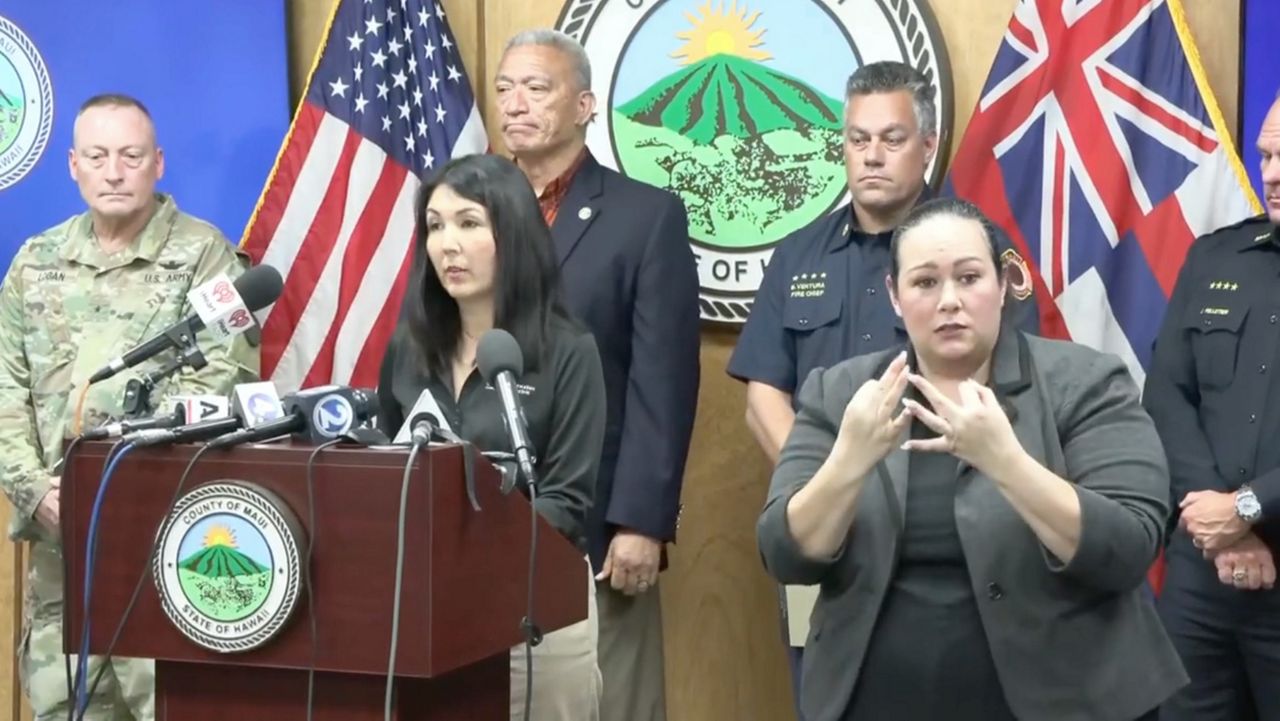The risks of cutting power to people who rely on specialized medical equipment and affecting the supply of water available to firefighters were factors in Maui Electric Co.’s decision not to de-energize power lines in West Maui as high winds threatened to topple utility poles and, later, as those same winds fanned the flames that reduced Lahaina town to ash, according to Hawaiian Electric Co. CEO Shelee Kimura.
Fielding questions from reporters during a news briefing hosted by Gov. Josh Green on Monday, Kimura noted that Hawaii does not have a Public Safety Power Shutoff program, like those in California and other states, through which utilities may shut off power when there is an elevated threat of electrical infrastructure causing or exacerbating fires.
“We, like most utilities, don’t have that program,” she said. “And it’s worth noting that even in places where this has been used, it’s controversial and it’s not universally accepted.”
Over the weekend, a class-action suit was filed by LippSmith LLP, Foley Bezek Behle & Curtis LLP and Robertson & Associates LLP on behalf of Lahaina residents Monica and Rede Eder and other West Maui homeowners whose properties were lost during the fires.
The suit alleges that HECO was aware of the risk its infrastructure posed under the high-wind conditions but did not act appropriately to prevent their power lines from causing or contributing to the deadly fires.
“It can be seen as creating a hardship for those customers that have medical needs or that are at higher risk,” Kimura said of Public Safety Power Shutoff programs. “So, these programs, particularly for elders or other vulnerable people who have specialized medical equipment, this can be a very high risk for them. That’s why many (utilities) don’t have it. It also would require coordination with first responders and, as you have probably seen and maybe even reported, in Lahaina, the electricity powers the pumps that provide the water, and so that was also a critical need during that time.
“There are choices that need to be made,” she said. “And all of those factors play into it. Every utility will look at that differently depending on the situation.”
Kimura said HECO executives have not had the time or opportunity to reevaluate the decision, given the immediate concerns the utility has had to address.
She said the system that serves 12,000 West Maui customers was severely damaged and that all three transmission lines that serve the area were rendered inoperable.
“A day after inspecting the lines, our crews were able to restore (power to) almost half of all customers who had lost power. Hawaiian Electric worked closely with state and county emergency management teams who prioritized critical circuits for restoration, including those serving stores, pharmacies, gas stations, county water, wastewater and public safety facilities. That’s where we focus our work so that people would be able to get groceries, clean water, medicine, fuel and other essential life needs.
“On Saturday, we brought back circuit serving hotels and resorts along the Kaanapali Coast, making those places available for housing and many people displaced by the fires who were living in emergency shelters,” she said.
On Monday, HECO restored power to the Lahaina Civic Center and neighboring areas and made available a mobile substation to bring additional customers online.
Much work remains, Kimura said.
About 400 of the 750 poles in West Maui were damaged or destroyed, another 300 of 575 transformers were visibly damaged, and the Lahaina substation was destroyed.
Kimura said still-smoldering hot spots, falling trees and debris have hampered restoration efforts.
“This isn’t just about getting the power back on for us and for all of us,” she said. “It’s about providing support and, most important, hope to those who have lost family and friends, who have been left without homes and are experiencing an almost inconceivable grief.”
Michael Tsai covers local and state politics for Spectrum News Hawaii. He can be reached at michael.tsai@charter.com.



